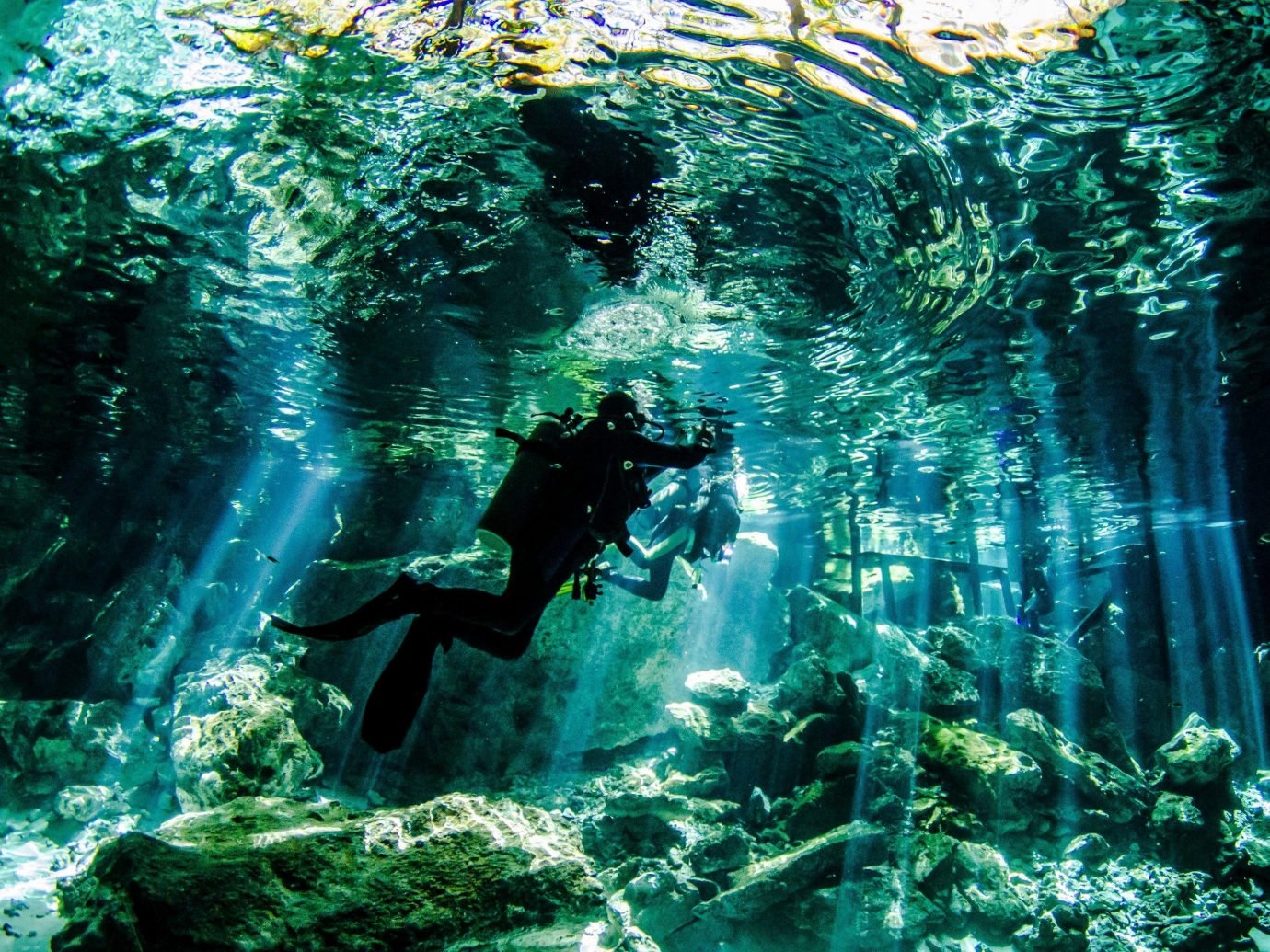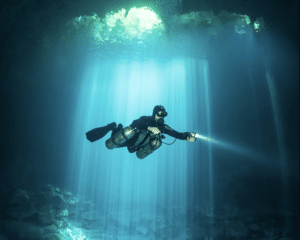Discover the captivating world of underwater exploration in the Yucatan Peninsula.
Content:
- Scuba Diving in Yucatan Peninsula
- Where to scuba dive in Yucatan Peninsula
- Best Dive Sites in Yucatan Peninsula
- How to get to Yucatan Peninsula
- When to dive in the Yucatan Peninsula
- Where to stay in Yucatan Peninsula
- What to bring for scuba diving in Yucatan Peninsula
- What should I consider for diving in a cenote?
- How much does it cost to dive in the Yucatan Peninsula
Scuba Diving in Yucatan Peninsula
Diving in the Yucatan Peninsula offers a unique blend of natural wonders and cultural heritage. The region’s underwater landscapes are truly breathtaking, but it’s not just about the marine life and rock formations; it’s a journey through time and culture.
There are more than 6,000 cenotes all around the Yucatan Peninsula and the majority of them are scattered around the Mexican states of Yucatan and Quintana Roo, a few also in Campeche. That makes the Yucatan Peninsula the largest and most important cenote complex in the world.
These ancient sinkholes were considered sacred by the ancient Mayan civilization. They were not only sources of fresh water but also believed to be portals to the underworld. Exploring these cenotes is like stepping into a hidden realm, an ethereal experience that connects you with both nature and history.
Descending into the Caribbean waters reveals an ecosystem alive with movement and vibrant colors. The gentle sway of the coral branches, the schools of tropical fish darting between crevices, and the hidden wonders of the sea floor create an awe-inspiring underwater symphony. The Yucatan Peninsula’s ocean diving promises a vibrant contrast to the cenote experience, inviting divers to explore a dynamic aquatic realm that continually unfolds with each dive.
Diving in the Yucatan Peninsula is not just about the individual dives; it’s about the overall experience. It’s about immersing yourself in a land of contrasts, where ancient civilizations meet modern adventure. It’s about mingling with fellow divers from around the world, sharing stories, and forging connections.
So, whether you’re a first-time diver eager to dip your toes into this aquatic wonderland or an experienced diver seeking new thrills, the Yucatan Peninsula promises an unforgettable journey into the heart of Mexico’s underwater treasures.
This guide will be your companion as you unlock the mysteries and embrace the magic of diving in Yucatan, a submerged paradise awaiting your exploration.

Where to scuba dive in the Yucatan Peninsula?
Mérida, Yucatán
Scuba diving in Mérida, despite the city not being directly on the coast, offers unique opportunities that attract divers from around the world.
Mérida is a gateway to some of the most breathtaking cenotes in the Yucatán Peninsula. These natural sinkholes filled with crystal-clear freshwater form a unique underground cave system. Cenote diving allows you to explore these mystical caverns, revealing stunning rock formations, clear waters, and a sense of adventure like no other.
Mérida’s cenotes offer options for divers of varying experience levels. There are cenotes suitable for beginners, with open water areas and gentle conditions, as well as more challenging cenotes for certified cave divers looking for an advanced adventure.
Worth mentioning that cave diving in Mérida often reaches much greater depths than that in Playa del Carmen, frequently starting around 40 meters and beyond.
Additionally, Mérida is located relatively close to both the Caribbean Sea and the Gulf of Mexico. This proximity provides divers with the opportunity to experience diverse underwater environments.
You can explore coastal reefs off the shores of places like Sisal, Progreso, and the island Alacranes, and then venture into the cenotes, creating a well-rounded diving experience that encompasses both the vibrant marine life of the open ocean and the captivating allure of the cenotes’ hidden world.
Mahahual, Yucatán
Mahahual is a small fishing village located 280 km south of Playa del Carmen (Mexico), very close to the border with Belize. It is part of the Costa Maya and the Mexican Caribbean Biosphere Reserve.
A natural paradise, it’s a sanctuary for diving enthusiasts, as it is home to the renowned Great Mayan Barrier Reef, the second-largest coral reef system in the world.
Mahahual boasts over 60 km of pristine reefs filled with mazes and nooks where marine life seeks refuge. Diving in Mahahual is known for its tranquility, free from uncomfortable currents, with excellent visibility, and offering scenic diving experiences.
In addition to the usual sightings of turtles, lobsters, rays, and moray eels, it’s also possible to encounter sharks, dolphins, and large creatures like manatees.

Playa del Carmen, Quintana Roo
On the eastern edge of the Yucatán Peninsula, divers can find magical cenotes, pelagic encounters, and beautiful reefs in Playa del Carmen on the Caribbean Sea.
The dive sites here feature stunning caverns and healthy reef systems along sandy shores. Playa del Carmen is home to a wide range of marine life, from massive sharks to tiny macro creatures.
The most significant wildlife attraction is the presence of female bull sharks, gracing the area from November to March. There are also eagle rays, loggerhead turtles, and green turtles frequently found in the vicinity.
Occasionally, sailfish and whale sharks can be observed at sites farther from the coast. Playa del Carmen’s vibrant reefs also host an array of tropical species.
Cozumel, Quintana Roo
Cozumel is one of the prime destinations in the Mexican Caribbean for scuba diving, as it is almost entirely surrounded by the Mesoamerican Reef (the second longest in the world), which has earned it recognition as one of the top five diving spots globally.
Here, you’ll discover over 40 distinct dive sites, with depths ranging from 3 to 30 meters (10-100 feet), teeming with tropical fish, vibrant coral reefs, and serving as the habitat for numerous marine species.
Diving in the reefs of Cozumel offers one of the most fantastic experiences, both for beginners starting to discover marine life and for experienced divers looking to venture into night diving.
Thanks to its 287 species of fish, 27 species of sponges, and 77 types of corals, this barrier reef was declared a National Marine Park in 1996.
Tulum, Quintana Roo
The new Caribbean gem that houses the most beautiful cenotes on the shores of Quintana Roo, offers the opportunity to experience diving within majestic underwater caves, allowing a journey through time to uncover ancestral secrets of the Mayan culture that have remained hidden beneath the water.
These submerged passages are unique in the world, and diving is one of the best ways to explore the incredible beauty of these hidden worlds, known to many as the liquid heart of the Riviera Maya.
In Tulum, cave diving takes on an astonishing twist as well, with some underwater caves reaching depths of just around 6 meters of water, offering an intimate and mesmerizing encounter with the cave formations and their ethereal allure.
Best Dive Sites in Yucatán
The Yucatan Peninsula in Mexico is famous for its spectacular cenotes and beautiful crystal-clear waters. Here are some of the best diving sites in the region:
Cenotes
Cenotes are natural sinkholes formed when the limestone bedrock collapses, exposing groundwater underneath. They are typically found in areas with low water tables, and the Yucatán Peninsula is home to thousands of them. Over millions of years, rainwater slowly dissolved the porous limestone, carving out intricate networks of underground rivers and caves.
These geological wonders have been a vital source of freshwater for the region’s inhabitants for millennia. The Maya civilization, which dominated the area between 2000 BC and 1500 AD, considered cenotes sacred and believed they were portals to the underworld, where the gods and spirits resided. Today, these captivating formations continue to hold a mystical allure for both locals and visitors alike.
Cenotes can be categorized into three main types: semi-open, open, and closed cenotes. Semi-open cenotes feature large entrances that allow natural light to penetrate, creating a transition between illuminated areas and deeper, more shadowed sections. Open cenotes provide wide entrances that flood the underwater environment with sunlight, offering a less confined and more traditional diving experience. Closed cenotes have narrow entrances leading to intricate cave systems, necessitating specialized training and equipment for divers to navigate through dark passages and explore the hidden depths.
Each type offers a distinct diving adventure…
MÉRIDA
Cenote Kankirixche
The municipality of Abalá, located to the west of Yucatán, is home to the Kankirixche cenote, which translates to ‘yellow fruit’ in Maya, and is known for being one of the ideal spots for diving.
This cenote is semi-open with a vertical drop, equipped with a wooden staircase and platform for accessing the water surface.
The water’s color is blue, measuring 25 meters in length by 15 meters in width, with a maximum depth of 50 meters and a minimum of 2 meters.
Inside, it features a cavern at a depth of 50 meters, with expansive underwater galleries and good visibility, making it an ideal site for diving.
Its current use is for tourism, offering optimal conditions for swimming, diving, and observing.
It is recommended to use life jackets, avoid the use of sunscreens, and exercise caution while descending the staircase.

Cenote Nah Yah
The Nah Yah cenote is located about 53.6 kilometers from the city of Merida, on the Acanceh-Tecoh road, heading south towards the Telchaquillo community.
It’s a semi-open cenote, with a 9-meter freefall and blue waters, a true testament to the wonders of nature. Its waters are blue, with a maximum depth of 27 meters. It’s one of the most popular for cave diving, although, of course, specialized equipment is necessary, and you must do it with a diving center, holding an Open Water certification as a diver.
Cenote Noh Mozón
The Noh Mozón cenote is of the open type and has a 9-meter freefall. To access it, you have to descend a wooden staircase that ends in a platform for jumping into the water, which has a crystal-clear blue color and a depth of 32 m max depth in the cavern zone and 48 m max depth in the cave zone.
This cenote is one of the lesser-known ones; however, it’s also one of the most beautiful and impressive. Access is a bit tricky; it’s located 71 kilometers from Merida, inside Pixyah. You have to take the Merida-Cancun highway.
Cenote X’Batun
X-Batún is an open-type cenote, which is accessed by a natural slope, and its max depth is approximately 58 meters. It’s one of the few cenotes with vegetation both inside and outside, making it a preferred destination for photography enthusiasts.
Furthermore, due to this same quality of abundant wildlife, it’s an excellent place for diving and observing various species of fish and aquatic plants.
PLAYA DEL CARMEN
Cenote Azul
Nestled within the Yucatán’s lush landscape, Cenote Azul’s crystalline waters cast a spell of awe. A paradise for aquatic enthusiasts, it welcomes both newcomers and seasoned divers, offering shallow sections for novice explorers and captivating depths for the more experienced.
Below the surface, a world of wonder unfolds—rock formations tell tales of time, and colorful marine life dances amid the azure backdrop. Cenote Azul isn’t just a cenote; it’s an aquatic gallery, an immersion into the beauty our planet has to offer, an open invitation to uncover the magic beneath the serene waters, where each dive is a brushstroke on the canvas of exploration.
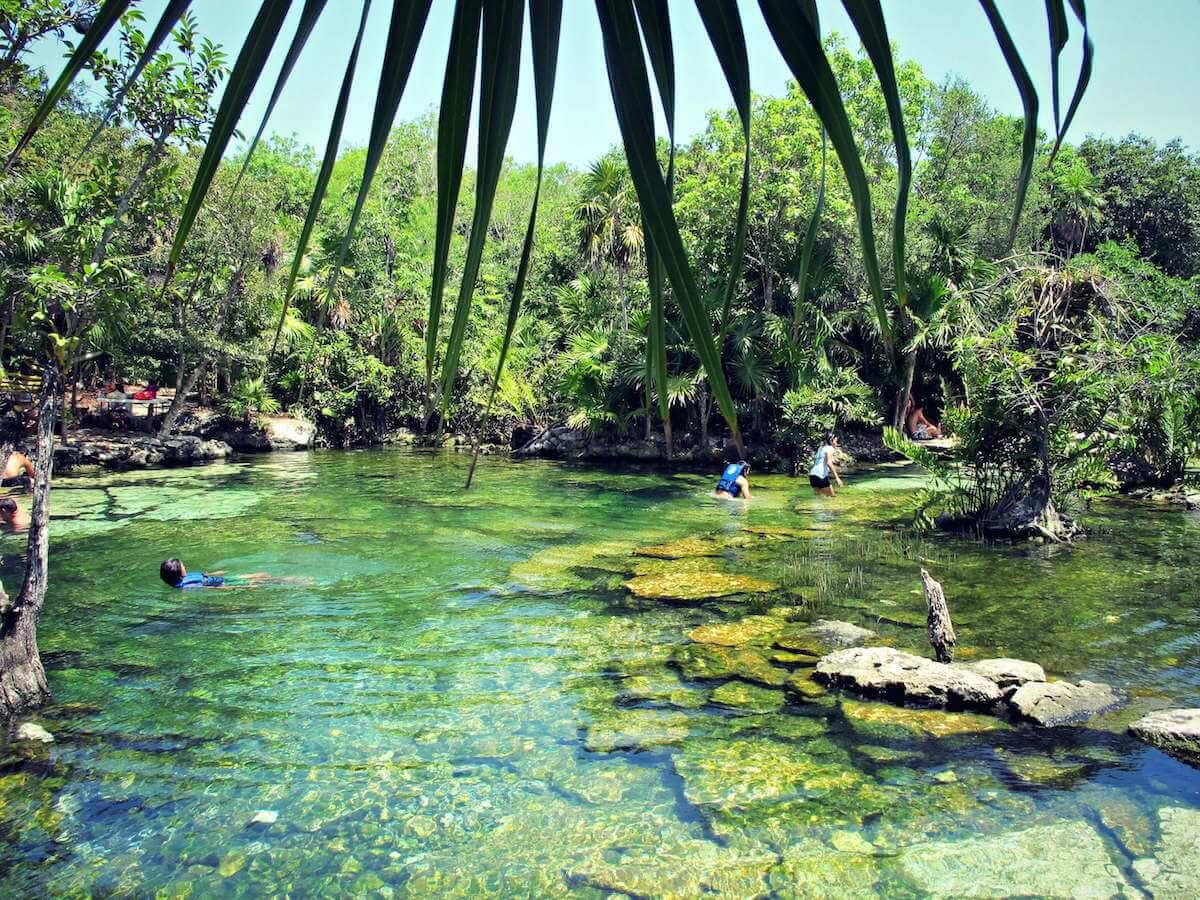
Cenote Zacil-Ha
Tucked away in the Yucatán’s embrace, Cenote Zacil-Ha unveils a tranquil haven for those seeking the extraordinary. Its allure lies in the captivating fusion of saltwater and freshwater, a dance of elements that creates a mesmerizing halocline. As divers venture deeper, the meeting of these waters unfolds in a visual spectacle, like a liquid mirage.
What sets Zacil-Ha apart is its serene seclusion; it’s a hidden gem away from the crowds, allowing divers to submerge themselves in tranquility. Here, the natural symphony of water and solitude harmonize, creating an unspoiled diving experience, etching indelible memories of serenity amidst nature’s watery canvas.
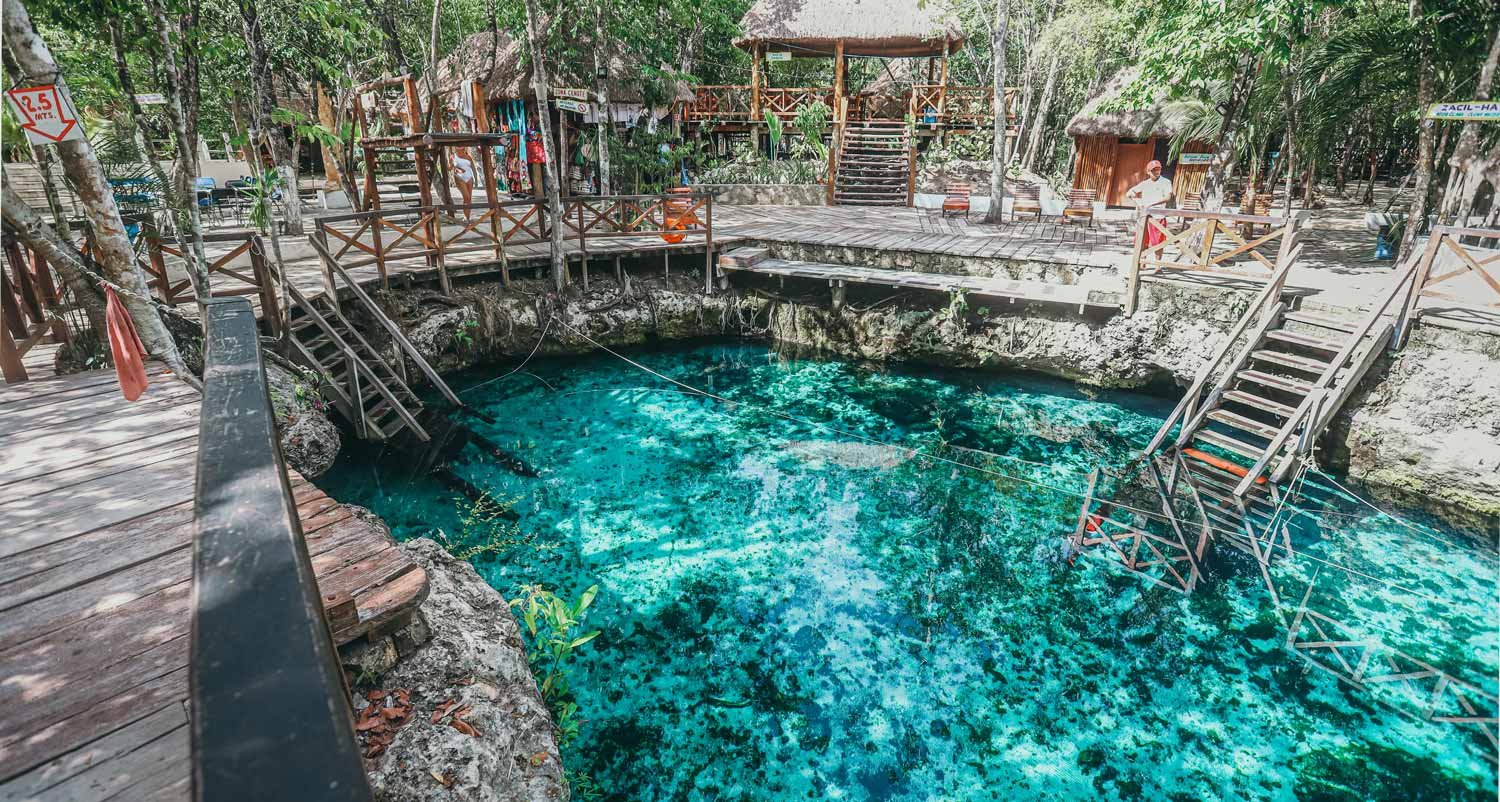
Cenote Carwash
Belying its unassuming name, Cenote Carwash invites adventurers into a hidden world of wonder. Within its depths lies an enthralling cave system adorned with delicate stalactite and stalagmite formations, a testament to the intricate artistry of nature. What makes Carwash truly special is its welcoming accessibility, accommodating divers from all walks of experience.
From novices to experts, each can appreciate the tapestry of underwater life that flourishes here. This cenote is a living canvas where skill levels converge, offering a chance for all to explore and uncover the secrets that have formed over ages, beneath the gentle currents of Cenote Carwash.
Cenote Cristalino
Cenote Cristalino, true to its name, reveals waters of unparalleled clarity. A paradise for both divers and snorkelers, it offers an exquisite aquatic world to explore. Divers are beckoned into a realm of enchantment, where underwater passages unveil hidden mysteries, and intricate rock formations paint a captivating canvas of time.
Amidst this crystalline beauty, a bustling community of aquatic life thrives, offering a vibrant spectacle of colors and movements. Here, the very essence of the cenote invites you to dive into its depths, embracing a symphony of nature’s artistry that leaves a lasting impression, a treasure trove for all who venture into Cenote Cristalino.
Cenote Jardin Del Eden
Nestled beneath the Yucatán’s emerald canopy, Cenote Jardin Del Eden, or Cenote Ponderosa, stands as a cherished haven for those enchanted by nature’s beauty. Its remarkable underwater clarity unveils an ethereal world, where visibility seems boundless, granting divers an intimate connection with aquatic life. As you venture through the tranquil waters, a lush underwater garden comes to life, a tapestry of vibrant vegetation swaying to the rhythm of gentle currents.
This cenote’s embrace is a gift to nature enthusiasts, offering an enchanting window into the delicate balance that thrives below the surface. It’s a sanctuary, where every dive reveals the poetry of life in a secret garden, Cenote Jardin Del Eden.
TULUM
Cenote Dos Ojos
An iconic cenote, Dos Ojos enchants with its twin sinkholes, each revealing a mesmerizing labyrinth of submerged caves. The crystal-clear waters shimmer under sunlight, illuminating the surreal rock formations below. Diving here feels like exploring a secret underwater realm, with tunnels connecting chambers adorned with stalactites.
The cenote is a playground for divers of all levels, offering both easy routes and challenging cave passages, a unique adventure into the heart of the Yucatán’s subterranean beauty.

Cenote The Pit
A dive into the abyss, The Pit is for the experienced thrill-seekers. Its extreme depth plunges into darkness, creating a mystical atmosphere as divers encounter the halocline, where saltwater and freshwater blend in an eerie spectacle.
The Pit’s allure is the enigmatic, profound experience, a thrilling descent into the unknown, where the vastness and the depths of this cenote leave a profound impression.
Cenote Taj Ma Ha
A hidden gem near Playa del Carmen, Cenote Taj Ma Ha welcomes divers to an enchanting world of natural beauty. Its name, meaning “House of Water,” suits this cenote well, with its interconnected caverns resembling an aquatic mansion.
As divers navigate its chambers, they’re greeted by vibrant flora, shafts of sunlight filtering through, and an underwater dreamscape. Taj Ma Ha’s serenity, combined with its accessible yet captivating environment, make it a favorite for those seeking a unique and picturesque dive.
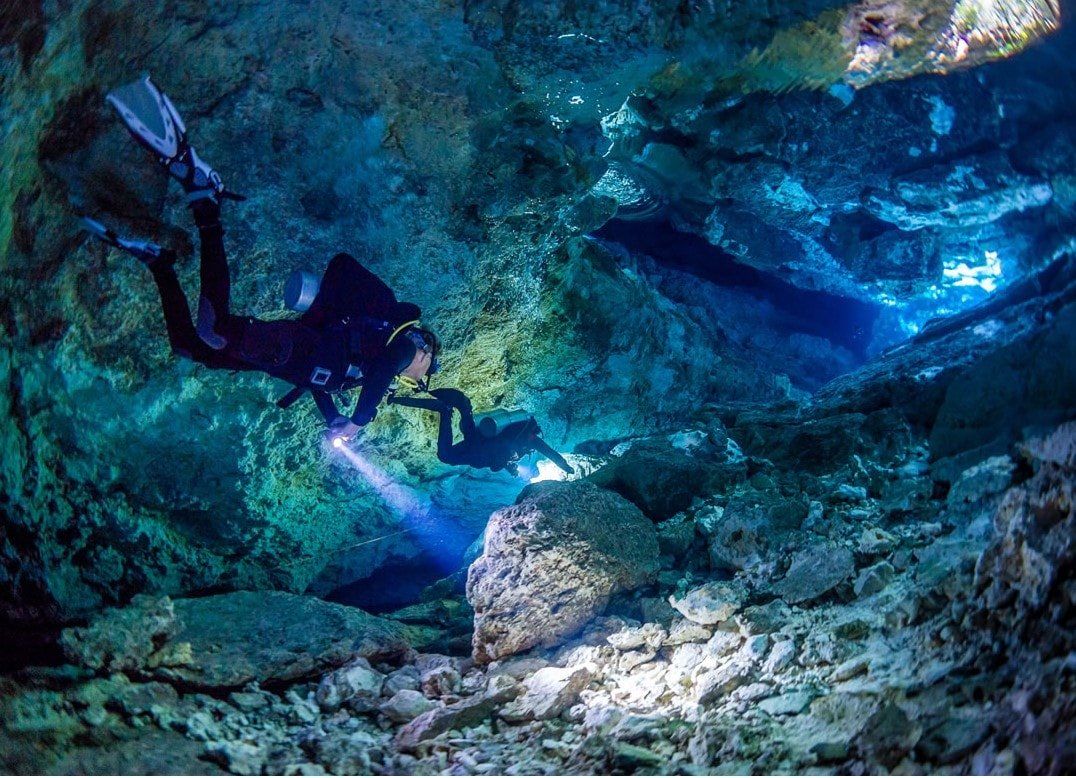
Cenote Angelita
A cenote that defies expectations, Angelita is famed for its “underwater river.” At around 100 feet, a dense cloud of hydrogen sulfide creates a mystical, ethereal appearance, like a flowing river suspended in the sky.
This advanced-level dive is not for the faint of heart, requiring experienced divers to fully appreciate its breathtaking beauty. Descending through the cloud, you’re rewarded with a hauntingly beautiful sight, a testament to the wonders nature can create.
Cenote Casa Cenote
Unlike traditional underground cenotes, Casa Cenote is an open-air cenote connected to the ocean, creating a unique brackish environment. As you glide through the clear water, you’ll find a captivating mix of freshwater and saltwater species, surrounded by mangrove trees.
Casa Cenote offers a relaxing, picturesque dive, making it a popular spot for snorkeling and easy diving, a refreshing aquatic haven with a touch of coastal charm.

While the Yucatán Peninsula is renowned for its stunning cenotes and vibrant marine life, it’s important to note that it doesn’t have the same extensive coastline as some other coastal regions in Mexico.
However, there are a few excellent coastal areas where you can enjoy diving along the Yucatán Peninsula. Here are some of the best beach destinations for diving in the region:
SISAL
This Yucatecan “Pueblo Mágico,” located just 50 minutes from Mérida, is an underwater paradise.
When we think of diving, the Caribbean always comes to mind, but Yucatán holds a true hidden treasure in Sisal. Immersing yourself in its waters, you’ll encounter a wide variety of fish and other creatures such as sea turtles.
Suddenly, you’ll catch sight of the remains of an old British steamship that used to trade slaves from the recently conquered Yucatán Peninsula. The shallow waters make this tour ideal for families and non-divers to engage in snorkeling and catch a glimpse of some of the ships.
Explore other incredible sites such as a Dutch warship from 1722, a steel fishing boat from about 60 years ago, the sunken 17th-century statue of Jesus, the submerged lighthouse, and more.
PROGRESO
Diving in Progreso offers a different experience compared to cenote diving. Progreso Beach is known for its shallow and calm waters, making it a suitable spot for beginner divers, snorkelers, and those looking for a more relaxed underwater exploration.
ALACRANES REEF
The largest coral reef in the Gulf of Mexico is located 109 kilometers (68 miles) off the coast.
It’s made up of five islands with vibrant corals and shipwrecks, and the reef is teeming with marine life including turtles and marine mammals.
This site isn’t on many dive shops’ itineraries and dive destinations, it is only accessible by liveaboard diving.
COZUMEL
Cozumel is perhaps the most famous diving destination in the Yucatán Peninsula. The island’s coastline is surrounded by the Mesoamerican Barrier Reef System, the second-largest coral reef system in the world. The dive sites here offer breathtaking underwater landscapes, colorful coral formations, and a diverse array of marine life. Some popular sites include Palancar Reef, Columbia Wall, and Santa Rosa Wall.
ISLA MUJERES
This beautiful island near Cancún is known for its clear waters and proximity to the whale shark migration route (seasonal). While it’s not a traditional diving destination, you can enjoy snorkeling with these gentle giants and explore the vibrant underwater world.
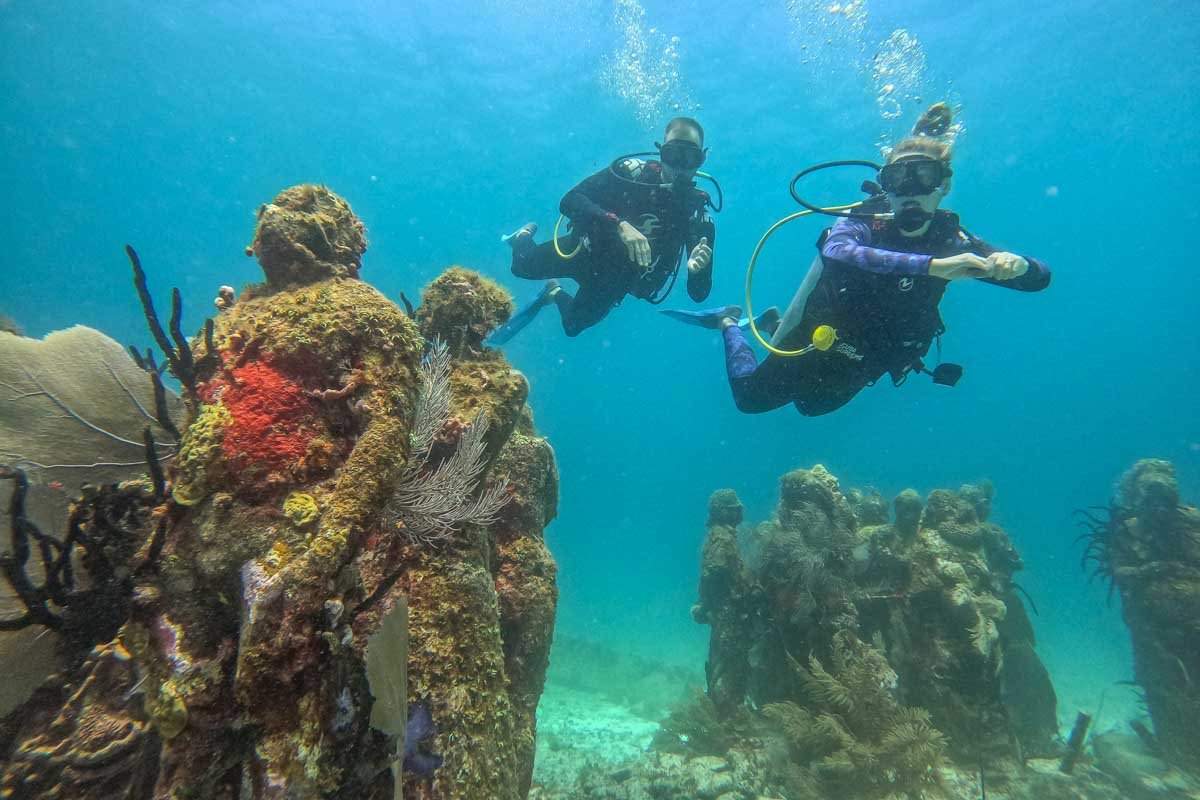
AKUMAL
Known for its sea turtle population, Akumal offers fantastic snorkeling opportunities. The calm, shallow waters make it ideal for observing sea turtles and other marine life.
MAHAHUAL
Although not known for extensive reef systems directly off the beach, Mahahual is a gateway to the Banco Chinchorro Atoll, which offers excellent diving experiences, especially for those interested in exploring shipwrecks and diverse marine ecosystems.
PLAYA DEL CARMEN
While not primarily a beach diving destination, Playa del Carmen provides easy access to the nearby Cozumel reefs via ferry. It’s an ideal base for combining coastal exploration with trips to renowned dive sites.
TULUM
Tulum has beautiful beaches and provides easy access to the cenotes. While it’s not a traditional beach diving spot, it’s a fantastic location for those interested in both cenote diving and coastal relaxation.
Keep in mind that the Yucatán Peninsula’s primary draw for diving lies in its cenotes, so combining cenote diving with trips to the coastal spots mentioned above is a great way to experience the underwater beauty of the region.

How to get to the Yucatán Península?
Getting to the Yucatán Peninsula is relatively straightforward, and you have several transportation options, including air travel and land routes:
- 1. By Air: The most common way to reach the Yucatán Peninsula is by flying into one of the major airports in the region. The two main airports are:
- Cancún International Airport (CUN): This airport serves the eastern part of the peninsula, including Cancún, Playa del Carmen, and Cozumel. It’s one of the busiest airports in Mexico and offers numerous international flights.
- Mérida International Airport (MID): Located in the capital city of Yucatán, this airport serves the western part of the peninsula, including Mérida and nearby attractions.
- 2. By Land: If you’re already in Mexico or prefer a land route, you can take buses or drive to the Yucatán Peninsula. There are well-maintained highways connecting the peninsula to other parts of Mexico. The most common land routes are:
- From Cancún to the rest of the peninsula: If you arrive in Cancún, you can take buses, rental cars, or organized tours to explore the surrounding areas.
- From other Mexican cities: If you’re coming from another city in Mexico, you can drive to the Yucatán Peninsula using the highway network. Keep in mind that the distance can be substantial, so plan accordingly.
- 3. Ferries: If you’re heading to Cozumel, there are passenger ferries that operate between Playa del Carmen and Cozumel. The ferry ride is relatively short and provides a convenient way to reach the island.
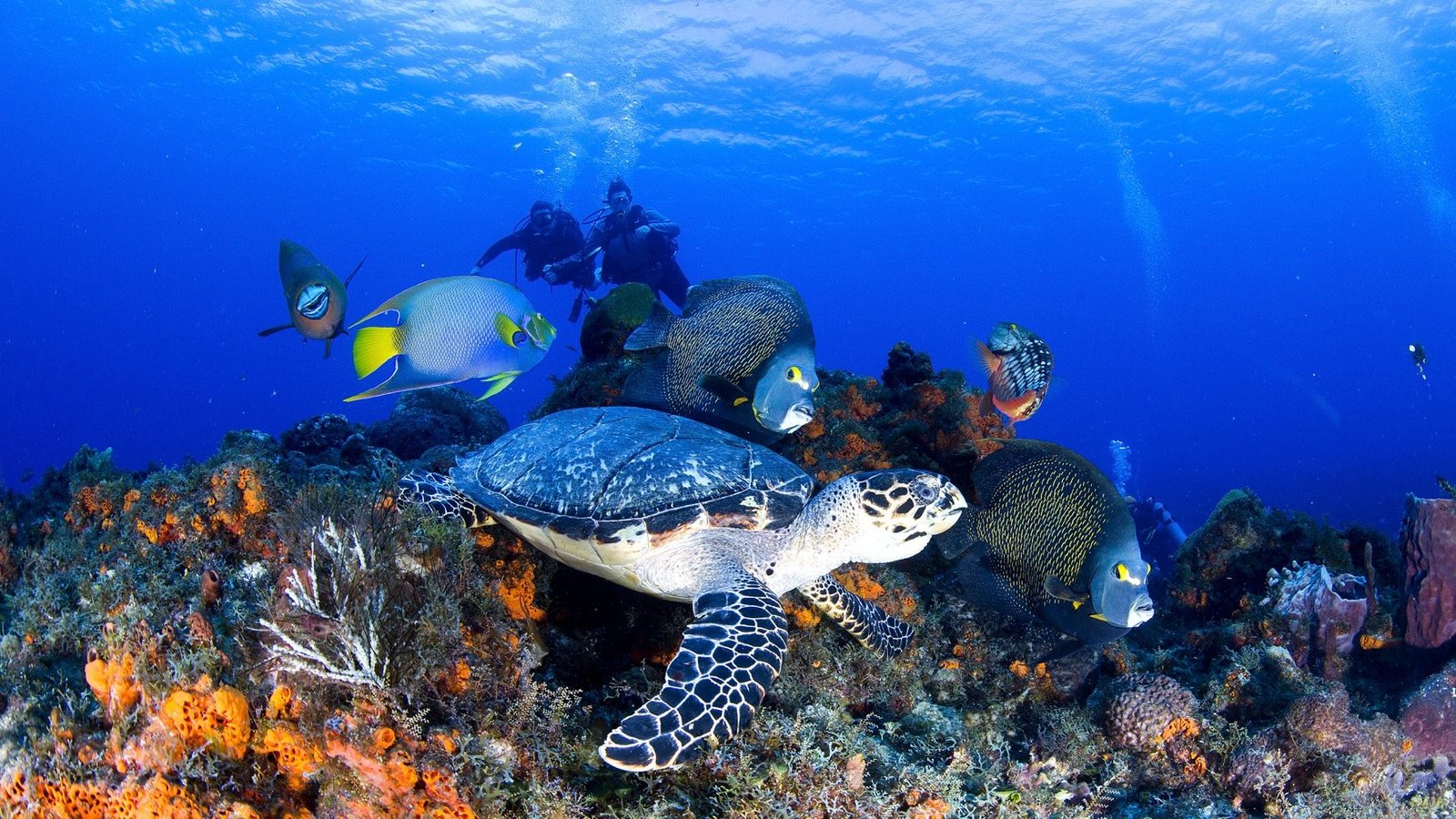
Once you’re in the Yucatán Peninsula, you can use local transportation, such as buses, rental cars, and taxis, to get around. Many tourists find it beneficial to rent a car, especially if they plan to explore various cenotes, ruins, and attractions outside major cities.
When to scuba dive in the the Yucatán Peninsula?
The Yucatán Peninsula offers great diving opportunities throughout the year, but the best time to dive can vary based on your preferences and the specific diving experiences you’re seeking. Here’s a breakdown of the different seasons and their diving characteristics:
- Cenote Diving: Cenote diving can be done year-round, but the dry season is often preferred for optimal visibility in these freshwater caves. If you’re particularly interested in cenote diving, the months from November to April are recommended.
- Dry Season Ocean Diving (November to April): This period is generally considered the best time for diving in the the Yucatán Peninsula. The weather is stable, with less rain and milder temperatures. Water visibility is excellent, making it ideal for both reef and cenote diving. This is also the peak tourist season, so popular dive sites might be busier.
- Whale Shark Season (June to September): If you’re interested in diving with whale sharks, this is the time to visit. The Yucatán Peninsula, particularly Isla Holbox and Isla Mujeres, is known for its whale shark encounters. It’s a unique and exhilarating experience.
- Rainy Season (May to October): While the rainy season brings more unpredictable weather and some rain, it can still be a good time for diving. The water temperature is warmer, and marine life activity is higher. However, you might encounter occasional storms, and visibility can vary due to runoff from rain. Keep in mind that some operators may reduce diving trips during heavy rain.

Ultimately, the best time to dive in the Yucatán Peninsula depends on your specific interests, comfort with weather conditions, and the type of diving experiences you’re looking for.
Be sure to check with local dive operators for the latest conditions and recommendations based on your chosen diving activities.
Where to stay in Yucatán Península?
If you’re interested in scuba diving in the Yucatán Peninsula, you’ll want to stay in a location that provides easy access to diving sites, dive operators, and other amenities that cater to divers. Here are a few popular places to consider for scuba diving accommodations:
- Mérida: While Mérida isn’t directly on the coast, it serves as a central base for exploring the Yucatán Peninsula. You can arrange diving trips to cenotes from Mérida, and it offers a more cultural and historical experience.
- Playa del Carmen: Located on the mainland, Playa del Carmen offers a lively atmosphere, beautiful beaches, and easy access to Cozumel for diving. You’ll find numerous dive shops and dive tour options.
- Tulum: Tulum is famous for its cenotes, which provide a unique diving experience. The area offers a mix of beachfront accommodations and those close to the cenotes.
- Cozumel: This island is a renowned scuba diving destination with fantastic coral reefs, underwater caves, and clear waters. There are plenty of dive shops and resorts catering to divers. Staying on Cozumel ensures you’re right at the heart of the diving action.
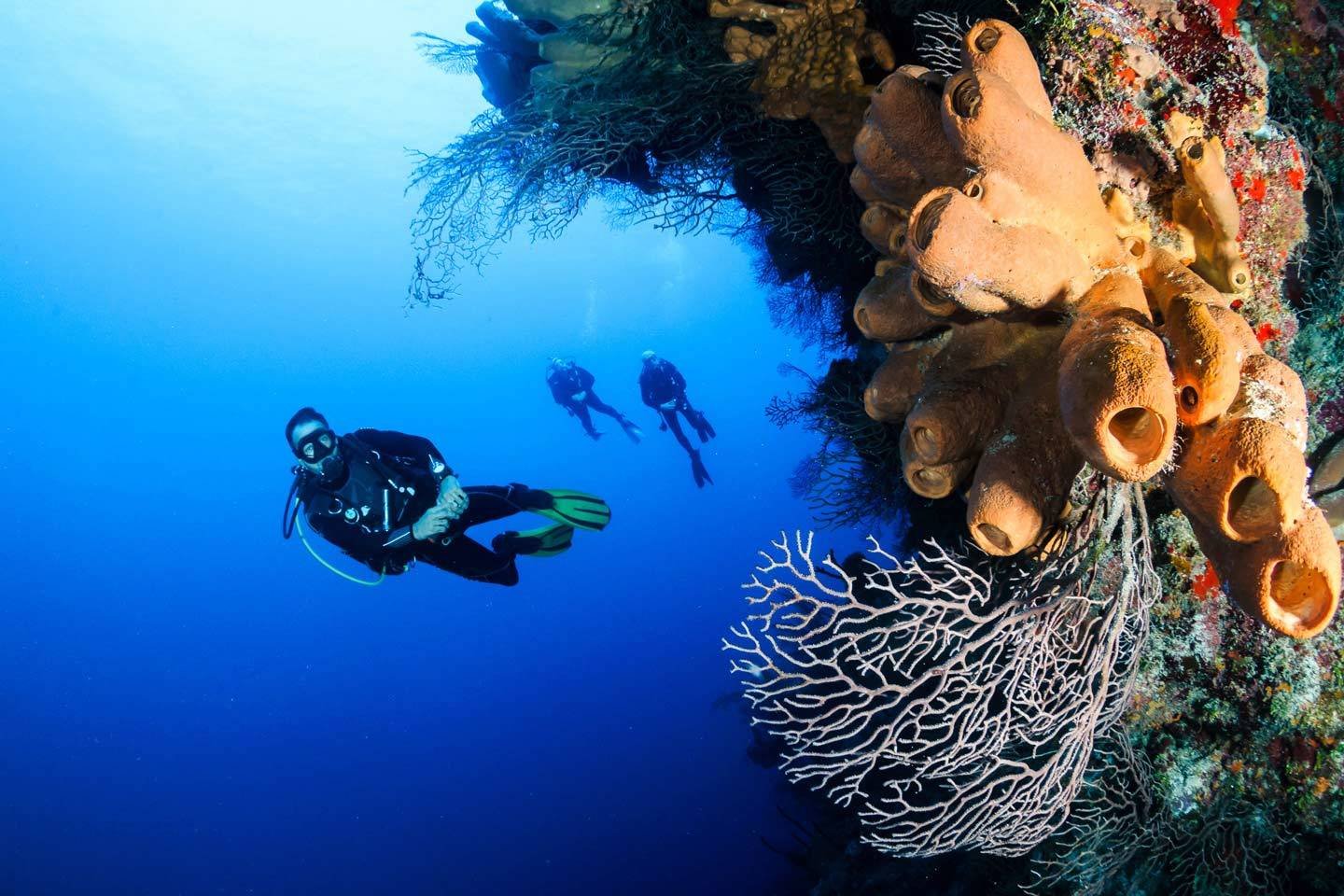
Remember to check the proximity to the diving sites you’re interested in, the available dive operators, and the type of diving experiences you’re looking for (reefs, cenotes, etc.).
Booking accommodations in advance, especially during peak diving seasons, is a good idea to ensure availability.
What to bring for scuba diving in the Yucatán Peninsula
When preparing for scuba diving in Yucatán, it’s essential to have the right gear and necessities to ensure a safe and enjoyable experience. Here’s a checklist of items to bring:
- Diving Certification: Ensure you bring your diving certification card and any required documentation to show your diving level. However, if you do not have a certification that’s okay! Get certified here!
- Swimsuit: Wear a comfortable swimsuit that you can wear under your wetsuit or diving gear.
- Diving Gear: If you have your own equipment bring them. Otherwise, most dive operators can provide rental gear.
- Underwater camera: You might want to bring an underwater camera and take home more than just memories.
- Sun Protection: Sunscreen, sunglasses, and a hat to protect yourself from the sun during surface intervals. We recommend using biodegradable sunscreen when diving the Cenotes. Sadly there is no regulation in place (yet), but the chemicals of normal sunscreens have changed the water quality in the past years.

Remember to double-check with your chosen dive operator about specific requirements and recommendations for diving in the Yucatán, as they may have additional suggestions based on the location, type of dives, and services they offer.
What should I consider for diving in a cenote?
To dive in any of the cenotes in Mexico, most dive companies will require you to have an open water diving certification. If you have that certification, you’ll be able to dive in the cenotes.
This means you’ll be able to see the natural light source and, therefore, identify the exit to the cavern at all times during the dive.
To fully submerge in the cenote cave system, a cave diving certification will be necessary. If you’re not certified, dive companies also offer certification courses and first time experiences, like DSDs.
Make sure to hire a guide who is fully certified and authorized. A good guide will suggest which cenote is suitable for you based on your diving level and what you’re interested in seeing.
How much does it cost to scuba dive in the Yucatán Peninsula?
The cost of diving in the Yucatán Peninsula can vary widely depending on several factors, including the type of diving you’re interested in, the specific dive site, the dive operator you choose, and the level of services provided. Here are some approximate price ranges for different types of diving experiences in the Yucatán Peninsula:
- Open Water Diving: The cost for a single open water dive in the Yucatán Peninsula can range from around $60 to $100 USD on average. This often includes equipment rental, a guide, and boat transportation if necessary.
- Cenote Diving: Cenote diving, being more specialized and potentially requiring additional equipment and training, tends to be more expensive. A single cenote dive can cost anywhere from $100 to $200 USD or more, depending on the complexity of the dive site and the services provided. Keep in mind that guided cave diving, which requires advanced cave diving certification, can cost even more due to the expertise needed for safe exploration.
- Dive Packages: Many dive operators offer packages that include multiple dives at a discounted rate. These packages can be a more cost-effective option if you plan to do several dives during your trip.
- Courses and Certifications: If you’re looking to get certified or take advanced diving courses, the costs can vary. An Open Water Diver certification course can range from around $300 to $500 USD, while more advanced courses like the Advanced Open Water Diver certification or specialty courses might have additional costs.
Remember that the prices mentioned are approximate ranges and can vary based on factors such as the location of the dive site, the reputation of the dive operator, the level of equipment provided, and additional services like transportation and meals. It’s important to research and compare different dive operators, read reviews, and inquire about what’s included in the price before making a decision.
Additionally, some dive operators might offer discounts for group bookings or for divers who opt for dive packages. Be sure to factor in any potential extra costs, such as equipment rental, tips for guides and boat crew, and any entrance fees for protected areas or marine parks.


